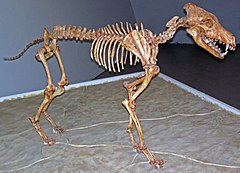Dire wolf
| Dire wolf Temporal range: Late Pleistocene – early Holocene (125,000–9,000 years ago)
| |
|---|---|

| |
| Mounted skeleton, Sternberg Museum of Natural History | |
| Scientific classification | |
| Domain: | Eukaryota |
| Kingdom: | Animalia |
| Phylum: | Chordata |
| Class: | Mammalia |
| Order: | Carnivora |
| Family: | Canidae |
| Genus: | Canis |
| Species: | †C. dirus
|
| Binomial name | |
| Canis dirus | |
| Subspecies | |
| Synonyms | |
The dire wolf (Canis dirus, "fearsome dog") is an extinct species of wolf in the genus Canis. It is one of the most famous prehistoric carnivores in North America. The dire wolf lived in the Americas during the Late Pleistocene and Early Holocene epochs (125,000–9,440 years ago).[9] The species was named in 1858, four years after the first specimen had been found.
Subspecies[change | change source]
Two subspecies are recognized. These subspecies are Canis dirus guildayi and Canis dirus dirus.[9] The dire wolf probably evolved from Armbruster's wolf (Canis armbrusteri) in North America.
The dire wolf was about the same size as the largest gray wolves alive now.[10]
Diet[change | change source]
The dire wolf probably ate horses, ground sloths, mastodons, bison, and camels. The dire wolf was probably a pack hunter. This means that many dire wolves would hunt for prey together. Modern wolves are also pack hunters.
Extinction[change | change source]
The dire wolf became extinct during the Quaternary extinction event.
References[change | change source]
- ↑ Leidy, J. (1858). "Notice of remains of extinct vertebrata, from the Valley of the Niobrara River, collected during the Exploring Expedition of 1857, in Nebraska, under the command of Lieut. G. K. Warren, U. S. Top. Eng., by Dr. F. V. Hayden, Geologist to the Expedition, Proceedings". Proceedings of the Academy of Natural Sciences of Philadelphia. 10: 21.
- ↑ 2.0 2.1 Kurten, B. (1984). "Geographic differentiation in the Rancholabrean dire wolf (Canis dirus Leidy) in North America". In Genoways, H. H.; Dawson, M. R. (eds.). Contributions in Quaternary Vertebrate Paleontology: A Volume in Memorial to John E. Guilday. Special Publication 8. Carnegie Museum of Natural History. pp. 218–227. ISBN 978-0-935868-07-4.
- ↑ Leidy, J. (1854). "Notice of some fossil bones discovered by Mr. Francis A. Lincke, in the banks of the Ohio River, Indiana". Proceedings of the Academy of Natural Sciences of Philadelphia. 7 (7): 200.
- ↑ Leidy, J. (1869). "The extinct mammalian fauna of Dakota and Nebraska, including an account of some allied forms from other localities, together with a synopsis of the mammalian remains of North America". Journal of the Academy of Natural Sciences of Philadelphia. 7: 368.
- ↑ Allen, J. A. (1876). "Description of some remains of an extinct species of wolf and an extinct species of deer from the lead region of the upper Mississippi". American Journal of Science. s3-11 (61): 47–51. doi:10.2475/ajs.s3-11.61.47. hdl:2027/hvd.32044107326068. S2CID 88320413.
- ↑ Sellards, E.H. (1916). "Human remains and associated fossils from the Pleistocene of Florida". Annual Report of the Florida Geological Survey. 8: 152.
- ↑ Merriam, J.C. (1918). "Note on the systematic position of the wolves of the Canis dirus group". Bulletin of the Department of Geology of the University of California. 10: 533.
- ↑ Frick, C. (1930). "Alaska's frozen fauna". Natural History (30): 71–80.
- ↑ 9.0 9.1 "Canis dirus :: Florida Museum of Natural History". www.floridamuseum.ufl.edu. 30 March 2017. Retrieved 2018-12-26.
- ↑ "Dire Wolf Fact Sheet". library.sandiegozoo.org. Archived from the original on 2012-05-06. Retrieved 2018-12-26.
Other websites[change | change source]
- For the younger readers - Dire Wolf by Marc Zabludoff, Marshall Cavendish, 2009
- The Evansville Dire Wolf
- Information on the dire wolf from the Illinois State Museum
